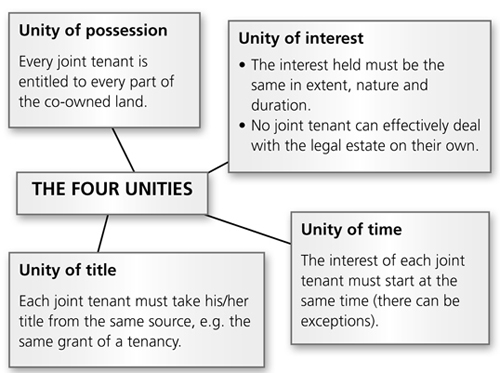Co-ownership

Co-ownership
Types of Co-ownership
The Joint Tenancy • The rights of survivorship; • the four unities: i) possession; ii) title; iii) interest; iv) time; • no share in property. | The Tenancy in Common • The right of survivorship does not operate. • Individual putative shares. |
Joint Tenancy or Tenancy in Common?
The following suggest a tenancy in common:
a) any words of severance;
b) any of the four unities absent;
c) unequal contributions;
d) commercial purchase;
e) lessees of business premises;
f) joint mortgages of property.
Where there is an express declaration on the conveyance the common law principles do not apply (Goodman v Gallant (1986)).
Methods of Severance
Statute: | a) S36(2) written notice. |
Common law: | b) Joint tenant (acting on his share): i) an act operating on a joint tenant’s share; ii) mutual agreement; iii) mutual conduct. c) Homicide. |
1. Co-ownership arises where two or more people have an interest in the same land at the same time.
2. Two types of Co-ownership are recognised today: the joint tenancy and the tenancy in common.
3. Under the joint tenancy, each joint tenant is said to be wholly entitled to the whole of the estate or interest that is the subject of Co-ownership.
4. The tenancy in common differs because each Co-owner is said to own a distinct share or a notional proportion of entitlement.
5. A joint tenancy may be severed and can become a tenancy in common either in relation to the whole of the property or for just a single share.
8.2 The Joint Tenancy
1. In a joint tenancy no tenant owns a specific share.
2. Any transfer of the legal title must be carried out by all the joint tenants together.
3. There are two main features of the joint tenancy:
 the right of survivorship (ius accrescendi); and
the right of survivorship (ius accrescendi); and
 the four unities.
the four unities.
8.2.1 The Right of Survivorship
1. Under the Law of Property Act s1(6) a legal estate is incapable of existing in divided shares.
2. On the death of one joint tenant the estate remains with the surviving joint tenants.
3. The joint tenancy ends when the property vests in a sole survivor.
4.